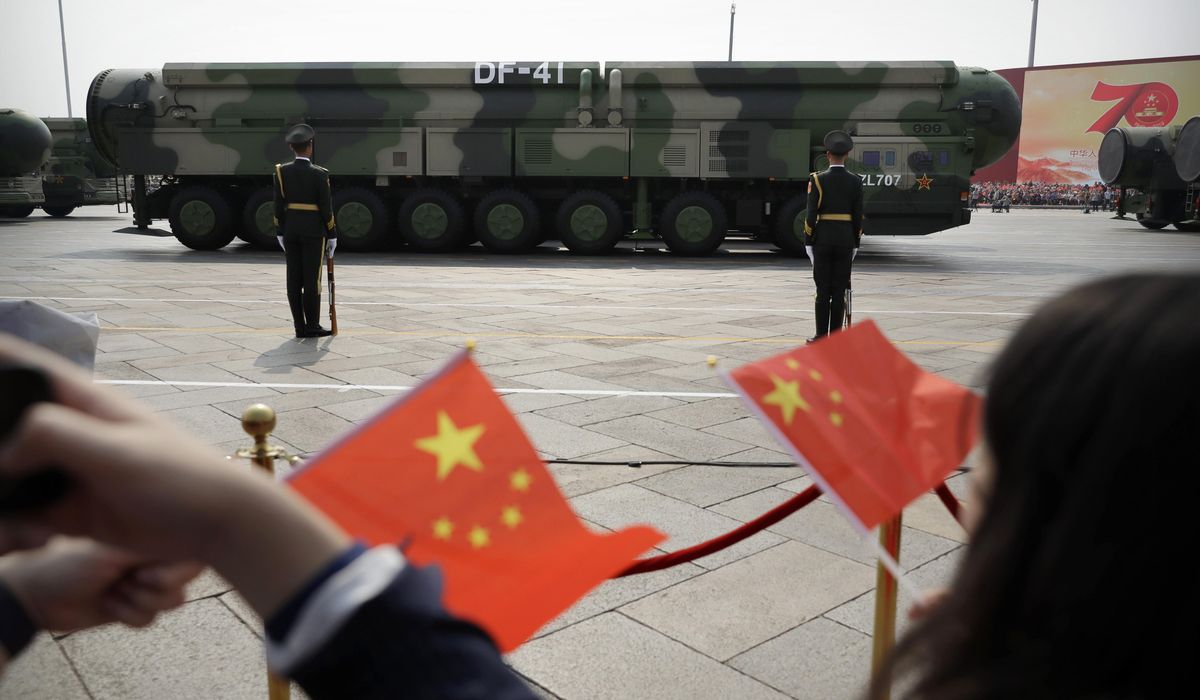
Arms control remains a central focus of Biden administration national security policy despite a nuclear weapons “breakout” by China and the deployment of cutting-edge new strategic weapons by Russia not covered by the New START Treaty, President Biden said in a letter Thursday.
Mr. Biden said the need for binding deals on nuclear weapons was as vital as any time since the collapse of the Soviet Union in the 1990s.
“Today — perhaps more than any other time since the Cold War — we must work to reduce the risk of an arms race or nuclear escalation,” Mr. Biden told the Arms Control Association, a private advocacy group. “My administration is committed to reducing the existential threat posed by nuclear weapons, protecting the American people and reinvigorating the global nuclear order to reduce the risk of use or proliferation of nuclear weapons.”
Mr. Biden said his decades-long support for arms control drove his decision in February 2021 to extend the expiring New START treaty with Russia for five years, just weeks into his presidency.
The Trump administration and private critics have contended that Moscow circumvented the treaty’s limits by building new and exotic strategic weapons not covered by the original New START deal negotiated by the Obama administration in 2011. The new weaponry includes the Poseidon high-speed underwater drone, which carries as megaton-class nuclear warhead; the Skyfall nuclear-powered and nuclear-armed cruise missile; and a hypersonic glide vehicle called Avangard.
China, which was not a signatory to New START, has refused for several years to engage the United States in nuclear arms reduction talks, saying its nuclear stockpile is far smaller than those of Russia and the U.S. China’s government has demanded a sharp reduction in U.S. and Russian nuclear arsenals as a precondition before it would consider joining the talks. But Beijing is rapidly building nuclear weapons and delivery systems in what U.S. Strategic Command head Adm. Charles Richard has called a “nuclear breakout” from its past, limited arsenal.
The Chinese are required under Article VI of the 1970 Nuclear Non-proliferation Treaty to pursue negotiations on ending the nuclear arms race and nuclear disarmament. China joined the treaty in 1992.
China and Russia have worked together to limit U.S. space warfare capabilities by introducing draft arms control treaties at the United Nations Conference on Disarmament prohibiting weapons in space. The United States has rejected those proposals, arguing both Beijing and Moscow have developed several types of space weapons.
China’s nuclear arsenal of around 250 warheads is being expanded rapidly by the development of three land-based nuclear missile fields in western China, where an estimated 350 new DF-41 multiple warheads will be deployed. China also recently tested a strategic hypersonic glide vehicle that orbits the earth and can strike targets on earth from any angle, making detection and tracking difficult.
Mr. Biden said arms control progress must extend beyond the extension of New START, which limits U.S. and Russian deployed warheads to 1,550. He said the strategic dialogue has to continue despite the sharp break in relations sparked by Moscow’s decision to invade neighboring Ukraine in February.
“Even as we rally the world to hold Russia accountable for its brutal and unprovoked war in Ukraine, we must continue to engage Russia on issues of strategy stability,” he said.
The Biden letter was published in a tweet by the Arms Control Association and confirmed by the Twitter account of Bonnie Jenkins, undersecretary of state for arms control and international security. A White House spokesman did not immediately respond to a request for comment on the letter.
Strategic arms talks with Russia were cut off by the United States in February following Moscow’s invasion of Ukraine. The talks were launched in 2021 with the goal of concluding a new arms pact and pursuing limits on cyberattacks and advanced nuclear technologies.
Adm. Richard, the Strategic Command leader, appeared to downplay the prospect of arms control during Senate testimony in March. Russia’s nuclear force included a broad range of weapons that can be rapidly armed with nuclear warheads, he said.
“As many as 2,000 nuclear weapons are not captured by existing arms control agreements; theater and tactical nuclear weapons are entirely outside of any treaty framework,” Adm. Richard said.
Adm. Richard said China’s conventional and nuclear forces are being modernized under a veil of secrecy.
“While China’s nuclear stockpile is currently smaller — but undergoing an unprecedented expansion — than those fielded by Russia and the United States, the size of a nation’s weapons stockpile is a crude measure of its overall strategic capability,” he said.
“To fully assess the China threat, it is also necessary to consider the capability of the associated delivery system, command and control, readiness, posture, doctrine and training. By these measures, China is already capable of executing any plausible nuclear employment strategy within their region and will soon be able to do so at intercontinental ranges as well. They are no longer a ‘lesser included case’ of the pacing nuclear threat, Russia.”
The admiral said New START for now provides helpful transparency and predictability for U.S. strategists regarding Russia’s arsenal. But he noted that “a considerable level of uncertainty remains regarding the scope and disposition of Russia’s nuclear arsenal, including non-deployed nuclear weapons and its novel systems that are not accounted for under the treaty.”
The buildup of strategic weapons outside the treaty is troubling because Russia’s nuclear weapons production system can deploy hundreds of warheads a year allowing Moscow to increase its overall nuclear stockpile “driven primarily by projected increases in unconstrained nuclear weapons — while our production capacity remains essentially nonexistent,” he said.
